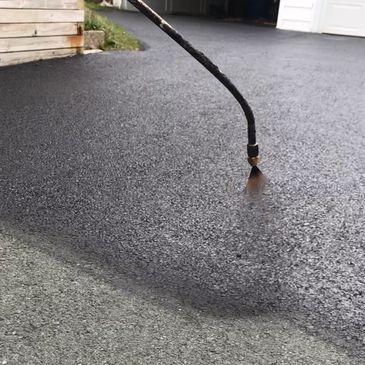Boost Sidewalk Efficiency: Cold Mix Asphalt Sealing Tips
Wiki Article
Cold Mix Asphalt Vs. Hot Mix Asphalt: Which Is Right for You?

Make-up Differences
Cold mix and warm mix asphalts vary significantly in their structure, with unique attributes that impact their performance and applications. Cold mix asphalt is produced by emulsifying the asphalt binder with water and an emulsifying representative before mixing it with aggregate. This technique permits the asphalt to be convenient at lower temperatures, making it optimal for temporary fixings and for use in cooler weather conditions. Hot mix asphalt, on the other hand, is produced at heats, usually in between 300-350 ° F, which aids to accomplish better compaction and an extra durable end product. The hot mix asphalt manufacturing procedure entails heating the aggregate and asphalt binder separately before combining them at the asphalt plant.
Additionally, cool mix asphalt often tends to be much less dense and much more flexible than hot mix asphalt. This versatility makes it much better matched for locations with higher levels of movement, such as driveways or roads with rush hour. In comparison, hot mix asphalt is known for its high toughness and resistance to rutting and fracturing, making it a recommended option for freeways and high-traffic roadways where longevity is vital.
Setup Process Differences
The process of setting up chilly mix and hot mix asphalt displays notable differences in their demands and procedures. Cold mix asphalt, being a more flexible material, can be used directly from the bag or container onto the pothole or harmed area. It requires very little preparation work, such as cleaning up the location and condensing the cool blend with hand tools. This makes it a practical option for quick and momentary repairs. On the other hand, warm mix asphalt requires an extra sophisticated installment procedure. It involves warming the combination to high temperatures prior to laying it down on an effectively ready base. The prep work consists of compacting the base, applying a tack layer, and using heavy machinery like pavers and compactors for a smooth and resilient finish. As a result of the home heating requirements, warm mix asphalt setups are usually accomplished by specialists with customized devices, making sure a more structurally audio and irreversible outcome.Durability and Durability Elements
When thinking about asphalt options, durability and long life are important variables to assess for enduring pavement efficiency,. Hot mix asphalt (HMA) is known for its exceptional sturdiness and durability. The high temperature levels during the blending and laying process allow for much better compaction, causing a denser and stronger sidewalk structure. This brings about HMA being a lot more resistant to rush hour tons, rough weather condition problems, and the impacts of aging contrasted to cool mix asphalt (CMA)
In regards to long life, HMA commonly outmatches CMA as a result of visit this web-site its superior strength and resistance buildings. HMA sidewalks have a longer service life, requiring less frequent repairs and upkeep, which can translate to set you back financial savings in the long run. Additionally, HMA sidewalks are extra easily customizable to meet details project requirements, further improving their resilience.
Cost Factors To Consider
Taking into consideration the economic ramifications is a crucial aspect when evaluating the choice between warm mix asphalt (HMA) and cool mix asphalt (CMA) for sidewalk jobs. While the preliminary cost of warm mix asphalt is normally higher than that of cool mix asphalt, HMA typically gives an extra cost-efficient solution in the long run due to its premium resilience and longevity.In addition to material costs, it's necessary to think about the costs associated with setup and upkeep when contrasting HMA and CMA. Ultimately, see the choice in between HMA and CMA ought to take into account not just the preliminary price however additionally the long-lasting monetary effects to identify the most cost-efficient option for the particular pavement job.
Environmental Influence Contrast
Contrast of the ecological influences in between warm mix asphalt (HMA) and cool mix asphalt (CMA) discloses distinctive differences in sustainability methods. HMA production requires high temperatures, leading to enhanced energy consumption and greenhouse gas emissions.Additionally, using CMA usually entails recycling existing asphalt pavement, advertising source preservation and lowering the amount of waste sent out to land fills. This reusing element even more boosts the sustainability of CMA compared to HMA. Generally, when thinking about the environmental impact, CMA becomes an extra ecologically sustainable choice as a result of its lower energy needs, minimized discharges, and the potential for reusing existing products. By going with CMA over HMA, road building and construction tasks can contribute positively to environmental preservation initiatives.
Conclusion
In final thought, the choice between cold mix asphalt (CMA) and hot mix asphalt (HMA) depends upon various factors such as structure, installment process, resilience, long life, price, and ecological impact. asphalt repair. While CMA provides a fast and cost-effective solution for small repair site here services, HMA ensures exceptional longevity and longevity for hefty web traffic locations. Consider these factors thoroughly to determine which type of asphalt is the appropriate choice for your paving needs

Taking into consideration the monetary effects is an important element when assessing the option in between hot mix asphalt (HMA) and chilly mix asphalt (CMA) for sidewalk projects. While the first expense of warm mix asphalt is normally higher than that of chilly mix asphalt, HMA often offers an extra cost-effective service in the lengthy run due to its remarkable longevity and longevity. asphalt patch repair.Contrast of the environmental influences in between hot mix asphalt (HMA) and cool mix asphalt (CMA) exposes distinct distinctions in sustainability practices.In final thought, the choice between chilly mix asphalt (CMA) and warm mix asphalt (HMA) depends on numerous variables such as composition, setup procedure, durability, longevity, cost, and environmental impact
Report this wiki page